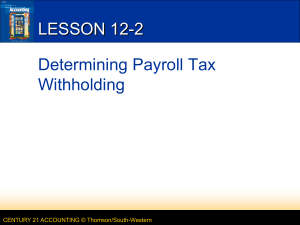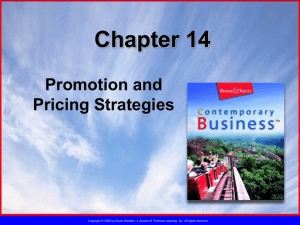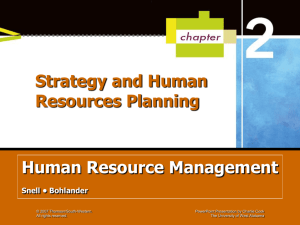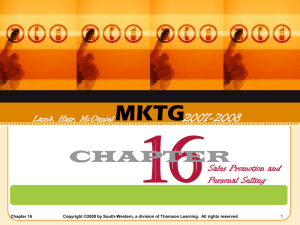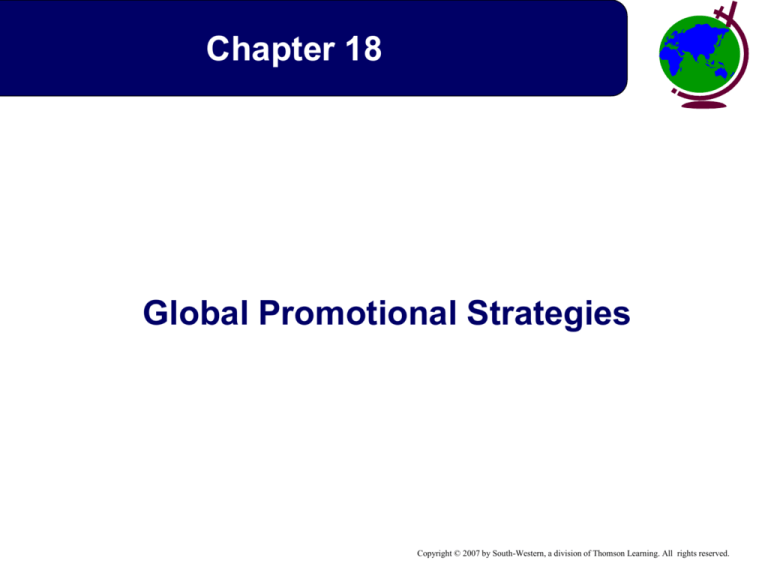
Chapter 18
Global Promotional Strategies
Copyright © 2007 by South-Western, a division of Thomson Learning. All rights reserved.
7 Stages in Promotional
Campaign Planning
Determine the target audience
Determine campaign objectives
Determine the budget
Determine media strategy
Determine the message
Determine campaign approach
Determine campaign effectiveness
Copyright © 2007 by South-Western, a division of Thomson Learning. All rights reserved.
Planning
Promotional Campaigns
• Target Audience
– Promotional campaigns affect more than
Who are our
consumers who purchase the product or
customers?
service.
• Suppliers, intermediaries, government,
local community, bankers and creditors,
media organizations, shareholders, and
employees.
– Research to determine multi-market target
audiences is required as firms become
more internationally involved.
– Cause related marketing
– Global image campaigns
Copyright © 2007 by South-Western, a division of Thomson Learning. All rights reserved.
Campaign Objectives
• Global objectives
– General guidelines and control for broad-based
campaigns (consistency of message).
• Regional objectives
• Local objectives
– Specific and measurable targets
(awareness, image, market
share) for individual markets.
Copyright © 2007 by South-Western, a division of Thomson Learning. All rights reserved.
The Budget
• The promotional budget links marketing objectives
with media, message, and control decisions.
• Acts as a control mechanism.
Copyright © 2007 by South-Western, a division of Thomson Learning. All rights reserved.
Media Strategy
• Development of media schedule
– target audience characteristics
– campaign objectives
– budget
• Media vehicle chosen based on
– media availability in market
– product or service offered
– audience media habits
Copyright © 2007 by South-Western, a division of Thomson Learning. All rights reserved.
Advertising Spending
Copyright © 2007 by South-Western, a division of Thomson Learning. All rights reserved.
Product Influences
• Product advertising restrictions
– National consumer protection regulations
– Special rules in certain markets
reflecting local cultural values.
• Advertiser’s responses
– Adaptation
– Innovation
• Product placement
– Diversification
Copyright © 2007 by South-Western, a division of Thomson Learning. All rights reserved.
Audience Characteristics
• Strategy is to reach the intended target audience with
the minimum of waste.
• Marketing strategist needs to know
– Media distribution (number of copies)
– Media audience composition
– Advertising exposure
Copyright © 2007 by South-Western, a division of Thomson Learning. All rights reserved.
Global Media
• Print publications providing global coverage with
regional language and content editions.
• Pan-regional radio and television, the Internet
• Important global media characteristics
– Targetability
– Client-compatible editorial
– Editorial quality
• Who advertises in global media?
– Airline, financial services,
telecommunication, automobile,and tobacco
companies
Copyright © 2007 by South-Western, a division of Thomson Learning. All rights reserved.
The Promotional Message
• Know customer habits and motivations: What are
consumers really buying and why?
• Factors in developing the message:
– Diffusion of the product or service into the market.
– Criteria on which customers evaluate the product.
– The product’s positioning.
• The ideal is to have a world brand.
– “…a product that is manufactured, packaged, and
positioned the same around the world.”
– Localize international symbols with regional or
country area themes and personalities.
Copyright © 2007 by South-Western, a division of Thomson Learning. All rights reserved.
The Media Campaign Approach
• What type of outside services to use?
• How to establish decision-making authority?
• Outside services are chosen by their quality of
coverage.
• Conflict in the use of mega-agencies
– Conflicts of interest when two competitors are
represented by the same agency
Copyright © 2007 by South-Western, a division of Thomson Learning. All rights reserved.
Decision-Making Authority
• Centralized or decentralized
decisions about advertising?
– Centralization= scale, synergy, consistency
– Decentralization= proximity, flexibility, sensibility
• Overall organizational goal to continually improve
advertising quality at the local level.
• Coordinated decentralized approach to pan-regional
campaign development
– strong central control
– knowledge of local markets
– avoids NIH syndrome
Copyright © 2007 by South-Western, a division of Thomson Learning. All rights reserved.
Measuring of Advertising
Effectiveness
• Typical effectiveness-testing techniques
– Pre-testing of copy appeal and brand recognition.
– Post-testing of product or brand recognition.
– Measuring campaign’s impact on sales.
• Measures
– Sales increases and sales pattern changes.
– Increases in consumer awareness and recall.
– Intention to buy, coupon return.
• There are no universally accepted parameters of
measurement and analysis to compare one country
audience to another.
Copyright © 2007 by South-Western, a division of Thomson Learning. All rights reserved.
Other Promotional Elements
• Personal Selling
– Typically associated big-ticket (high-priced) items such as
industrial goods.
– Proper training is crucial to success.
• Sales Promotions
– Couponing, sampling premiums, education and
demonstration, point-of-purchase, direct mail.
– The impact of promotions on intermediaries
50% off
must be carefully considered.
with
Coupon
– Varying local regulations may
prevent or limit the types and
use of sales promotions.
Copyright © 2007 by South-Western, a division of Thomson Learning. All rights reserved.
Public Relations
• Public Relations (PR) builds images
– PR’s goal is understanding and acceptance.
• PR provides internal and external acceptance for the
organization.
• Internally, PR functions to
– Provide Information through internal publications (e.g.,
newsletters and intranets).
– Help create the appropriate corporate culture.
• Externally, PR in multinational corporations is concerned with
– Building a global identity to build sales,product and service
differentiation.
– Providing information furthering marketing objectives.
– Anticipating and counting criticism of the organization.
– Taking a lead role in crisis management.
Copyright © 2007 by South-Western, a division of Thomson Learning. All rights reserved.









